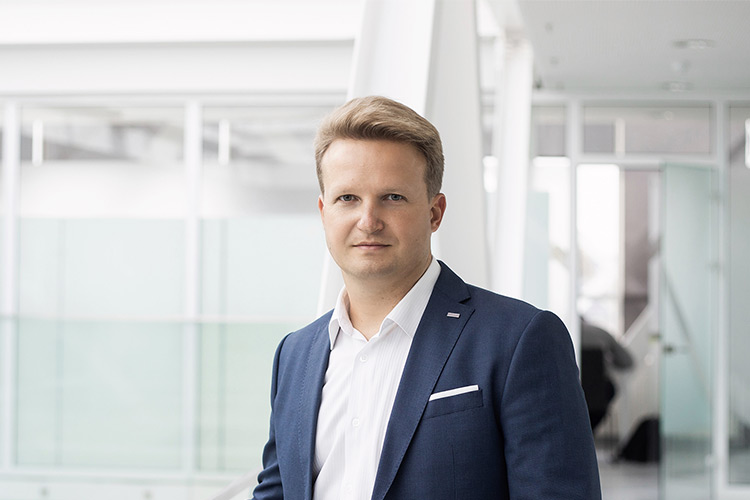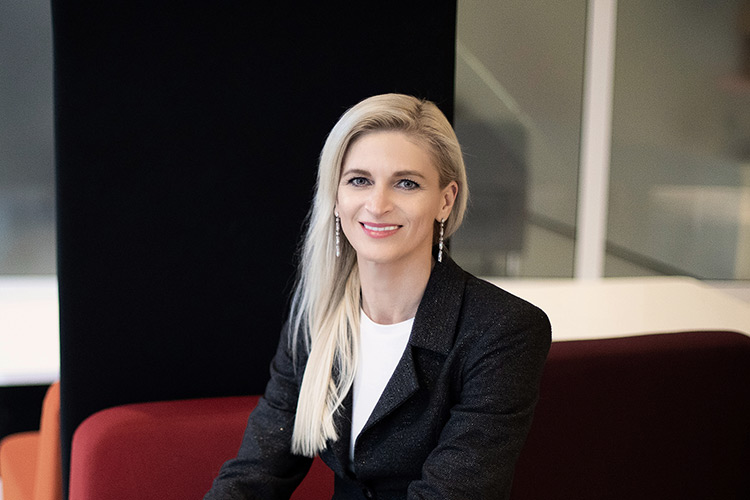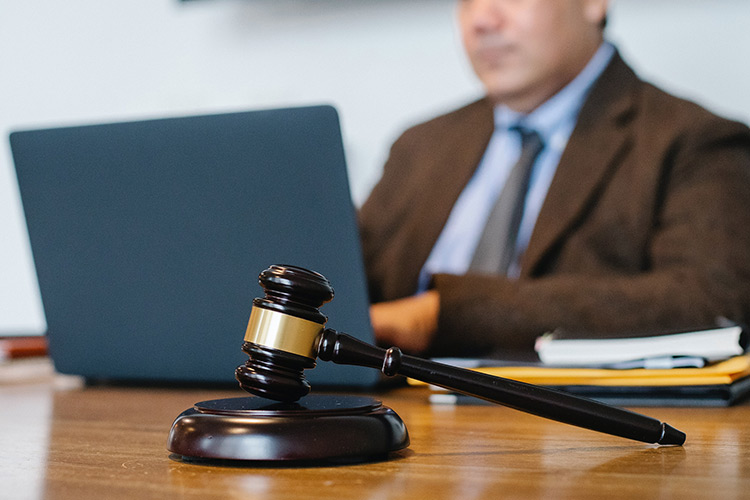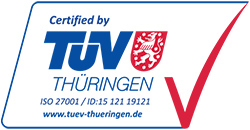Check .lt domain
Domain and trademark: how to protect them?
Any business start-up is inseparable from its name - company, trademark, domain. It is often the case that the first step is to create a domain for a website, and only then to develop a trademark and register a company. No matter which comes first - the chicken or the egg - it is essential to take care of domain and trademark protection at the start-up stage.
We will discuss with experts from the Internet Services Centre DOMREG at Kaunas University of Technology (KTU) and the State Patent Bureau (SPB) of the Republic of Lithuania about the various aspects the persons wishing to register a domain and a trademark, or a domain as a trademark should know with reference to case law.
The domain name should be registered immediately
Although the most difficult task when starting a business is to have a good idea and a prepared business plan, to get the financial resources to start the business, understand the market and find the first customers, finding a good domain name, a trademark and registering the company is also a challenge. Tomas Mackus, Head of KTU Internet Services Centre DOMREG, notes that many .lt domain names are created before starting any activities, as soon as an idea is born or a relevant trend for business is noticed in the market.
“It has become a common practice to check and create a domain before starting a business as soon as a name is created. Often, keywords or phrases related to the activities are chosen for domain names, and several related domains are created so that nobody could register similar but still available domains. This urgency is not surprising as the internet is very dynamic and has become very important in business.
The ideas for businesses and names are sometimes inspired by the market itself: the cryptocurrency boom presented an increase in the number of registrations of cryptocurrency-related domain names, coronavirus pandemic led to a sudden increase in the number of domain names with the words “mask” or “disinfection”, and the liberalisation of the electricity market led to an increase in the number of domain names related to solar and other forms of energy,” notes T. Mackus.
The reason why it is important to apply for a domain name urgently is that .lt domain names are established according to the principle of first come, first served - the first one to apply gets the domain.

Tomas Mackus, Head of KTU Internet Service Centre
“Often, once a domain name is created and verified, there is hesitation to submit the application for it. The domain is left vacant, and when they return a while later, it is too late: the domain name they came up with has been registered by others. To avoid losing a good idea, the domain name should be protected by registering it immediately,” advises T. Mackus, Head of KTU Internet Services Centre.
Are domain and trademark important assets?
Lina Mickienė, Deputy Director of the State Patent Bureau, says that in the digital age, entrepreneurs must pay special attention to the protection of business ideas and all other intellectual property (IP) and perceive it as a valuable asset.
“It is not easy for an entrepreneur to create a product, its design, come up with a name, develop a visual identity for a trademark, which is why the state guarantees protection and grants exclusive rights to the result of the intellectual activity. The IP registration is the only way to ensure a return on investment in the business, avoid copying and use of unique ideas, products or services without permission”, - emphasises L. Mickienė.
According to the interlocutor, there is a lot of debate as to whether domains are IP objects. Trademarks, designs, inventions, copyright objects, related rights objects, plant varieties, geographical indications, topographies - all these are commonly perceived as IP.
“These are the results created by a man, i.e., the results of the man’s creative activities in literature, art, science, business, industry and other areas. Therefore, since the second half of the 19th century, there has been an agreement between states, both in the Berne Convention for the Protection of Copyright and in the Paris Convention for the Protection of Industrial Property, on which objects are classified and protected as IP.
Domains are new in the context of the IP types, but they are directly related to creativity, because the creation of a domain name, a distinctive sign to be discovered on the internet, is also creativity. However, due to a number of principles - enforcement and protection of exclusive rights - a domain is not a true IP object,” - points out the SPB representative L. Mickienė.
Laura Subačienė, Lawyer at KTU Internet Services Centre DOMREG, believes that the lack of a legal framework prevents a clear understanding of the domain as an asset or an IP object. A trademark, design, website content, trademark recognition and traffic to an e-shop are considered important assets or investments. The domain, software for the content management system, and server services tend to be classified more as technical elements or services necessary for the operation of a website.
“As the Supreme Court of Lithuania has stated, a domain, like other IP objects, is an intangible object. However, could it be considered a property, as an asset? Most likely, when we speak of property, we are referring not to the domain itself but to the right to the registered domain. The right to the domain as an object of property can be inherited by the domain holder, sold, leased, included in a will, the domain can be treated as an intangible or current asset in a company, etc. However, it is difficult to unambiguously consider a domain as an IP object in the absence of a legal framework for the regulation of domains,” - the lawyer points out.
Lack of legal regulation on domains
Although the legal relations related to the registration, use of domains, dispute settlement, etc. are not regulated by Lithuanian legislation, this does not mean that rights and legitimate interests related to the possible illegal use of domains are not protected.

Laura Subačienė, Lawyer of KTU Internet Services Centre
“Lithuanian courts apply the analogy of law when dealing with disputes regarding the possible illegal use of domains. In disputes involving a domain and the name of a legal entity, the Civil Code applies; in disputes involving a domain and a trademark, the Law on Trademarks applied; and the Law on Competition is used to resolve disputes concerning unfair competition.
The legal relations related to the use of the .lt domain and the .eu domain are very similar in their essence and legal nature. Although the Regulation of the European Parliament and the Council on the implementation and functioning of the .eu top-level domain is applied in Lithuania without a direct impact on the legal regulation of the .lt domain, the provisions of the Regulation are relevant for the development of national case law,” - explains L. Subačienė, Lawyer of KTU Internet Services Centre DOMREG.
Besides the European Union document, Lithuania has a Government Resolution and the regulations of the Communications Regulatory Authority on the use of the name of Lithuania in domain names.
“We have a special legal regulation for trademarks - the Law on Trademarks, according to which a trademark is a very strong and recognised object of property and its owner is granted exclusive rights. This grant of exclusive rights is very relevant in a defensive sense because the owner of a trademark can prohibit others from using the trademark. If others use the trademark without the owner’s permission, damages and losses can be claimed, and legal action can be taken to prohibit the importation and sale of goods. A registered trademark grants many exclusive rights. One could say that trademarks are a traditional, well-known object of intellectual property, whereas a domain is not a direct object of intellectual property according to its purpose and legal regulation,” - summarises L. Mickienė, Deputy Director of the SPB.
Combining domain and trademark rights
According to the SPB representative, it is very important to know that intellectual property rights can be and are combined with other intangible objects.
“For example, an Apple product - a mobile telephone - has a product name, which can be a trademark, a copyrighted work, and the name of the legal entity. The external appearance of the product - what the product looks like - which would be an IP object - a design, could be a three-dimensional trademark. The technology of the product could be protected by invention patents, trade secrets, semiconductor topographies. Promotional material may also be protected as an object of design or by copyright.
The website and domain are also part of this scheme, because consumers, who wish to purchase or search for information about the product and know the trademark, conduct targeted searches in search engines or type the trademark and domain in the address bar of a web browser and are directed to a website. The website also contains intellectual property rights - copyrighted content, a trademark, the name of a legal entity, the design of the website and a unique domain name,” - states the SPB representative.
The purpose of a trademark is to distinguish the goods or services of one person from the goods and services of another person. A domain is a label that we use as an address to make a subject accessible online and the visitors could learn more about it or contact by email.
“A domain can be seen as the address of the house where you live. The house is your property and the address specifies where your house is. A person does not have exclusive rights to an address, but a right of defence arises when it concerns the house registered at that address or the people who live at that address.
A domain is an address on the internet indicating where digital services operated by a particular person can be accessed. The domain holder does not have exclusive rights to this address as an individual intellectual property object. However, the domain holder may have exclusive rights to the distinctive elements used in the domain and may defend his/her rights in the event of unfair competition, if others wish to use the domain without his/her consent, there is a potential misleading, etc.
The most common distinctive marks used in domains are trademarks, names of legal entities, names of copyrighted works, and geographical indications. Therefore, it can be stated that domains are closely related to intellectual property rights and should be mutually coordinated,” emphasises L. Subačienė, Lawyer at KTU Internet Services Centre DOMREG.
Other links and differences between a domain and a trademark
A domain name, like a trademark, has to be created by the entity itself. Both a domain name and a trademark may be written in words, letters, numbers or other permitted symbols. However, with the development of new technologies, it is becoming more and more common to see graphic, three-dimensional, colour, sound, motion, positional and multimedia trademarks on the market.
“When registering a domain, it is very important to come up with a domain name, the part of the word that distinguishes and identifies the domain. If the domain name is taken, e.g. parduotuvė.lt (shop.lt) is registered, then you can choose another one, e.g. parduotuvėlė.lt (boutique.lt), krautuvė.lt (littleshop.lt), etc. Such a descriptive web address can be registered as a domain, but if it is to be registered as a trademark, stricter rules apply.
To be registered and protected as a trademark, it must comply with the requirements set out by the Law on Trademarks. When registering a trademark, be aware that it must meet the absolute requirements, for example, shop and boutique have no distinctive features and are descriptive signs in the field of goods and services. Such a mark does not allow the consumer to distinguish between one producer of goods or services and another or identify the source of the goods or services.
In the case of a domain, this can exist perfectly well, as the system recognises the name if one letter is changed,” L. Mickienė, Deputy Director of the SPB, explains the differences between a domain name and a trademark.

Lina Mickienė, Deputy Director of the State Patent Bureau of the Republic of Lithuania
According to the expert, a domain can be a trademark, just as a domain can contain a trademark. A trademark can also be the name of a legal entity, or the names of works. They can also be in domains.
Trademarks are subject to territorial protection. A registered trademark is protected in Lithuania if it is registered in Lithuania. If a trademark is registered in the European Union, it is protected within the territories of all European Union countries. Trademark protection is valid for a fixed period of 10 years, after which it can be renewed.
A domain can also be associated with a specific territory, e.g. a .lt domain identifies the state of Lithuania. By choosing a .lt domain, an entity is probably associating its activities with Lithuania. Domains need to be renewed just like trademarks.
“When registering a domain, you have to check if an identical domain has not been created yet, therefore, a difference of at least one character is allowed, but the registration of trademarks is subject to much more requirements, which depend heavily on the legal regulation of the country.
Most EU countries use a preliminary examination system. This means that if, for example, an application for registration of the COCA-COLA trademark is filed, we, the State Patent Office, will accept an application and publish it, even if the person registering the trademark is Jonas Jonaitis. This is because it is a preliminary examination system and everything is left for later disputes. At this stage, the SPB only checks whether the mark can be a trademark, i.e., whether it meets the absolute requirements set out by the law.
Once an application is submitted and after absolute grounds examination a trademark application is published, the holders of the prior rights, e.g. the COCA-COLA company, which is the owner of this trademark, can oppose the application of Jonas Jonaitis by proving the prior rights. Therefore, the State Patent Bureau does not check whether the registered mark infringes the prior intellectual property rights of other persons; however, it settles disputes on the infringement of prior rights in a pre-trial administrative procedure,” - states the SPB representative.
As with the creation of a trademark, the registration of a domain also requires checking for prior rights to the label and seeing if there are any registered and pending identical trademarks, so as not to have any disputes later.
What are the steps to take before registering a domain?
As mentioned above, once you create a name, you should immediately register an available domain name and not disclose your business idea to other people. According to T. Mackus, Head of KTU Internet Service Centre DOMREG, domain names should be checked and registration applications should be submitted safely through an accredited .lt registrar.
“Many entrepreneurs at the start-up stage of their business are afraid of leaking information about their planned business. When checking the available domain names and creating a domain, this fear is understandable as a domain name can reveal a business idea.
You can safely check whether the domain you want is available on the .lt domain registry website at https://www.domreg.lt/en/services/whois/. You should always choose an accredited .lt domain registrar for domain registration.
The list of registered .lt domains is not publicly available, but it is possible to check the WHOIS database for public information on a particular domain”, - assures T. Mackus.
Before submitting an application for the creation of the .lt domain to an accredited registrar, one should make sure to search for the label used in the domain name in the trademark databases - national, European Union and international - the protection of which has been extended to the territory of Lithuania, as well as the Register of Legal Entities. This can be done on the following websites of the State Patent Bureau at https://vpb.lrv.lt/en/services/inventions/databases-1 and the Centre of Registers at https://www.registrucentras.lt/jar/p_en/ .
When using a domain name in commercial activities, a person should check if this domain name does not violate the rights of third parties. Only after making sure that there are no similar or identical trademarks or company names with the same sign that have been registered and submitted for registration, the domain, trademark and company name be registered. “Trademarks registered or submitted for registration earlier can avoid a domain name registered later if it is identical or confusingly similar to the trademark. And vice versa, it is worth making sure that the trademark will not violate the prior rights of other persons - the domain name, the name of the legal entity as they are commercial identifiers”, - emphasises L. Mickienė.

Which signs can violate prior rights?
One should be particularly careful when checking the prior rights of registered trademarks whose signs are artificially created (for example, “WIZZAIR”, “DELFI”) or are original combinations of common words (for example, “PIENO ŽVAIGŽDĖS”, “BATŲ KALNAS”, “FĖJŲ SLĖNIS”). According to the SPB representative, particular attention should be paid to avoiding similarities between the trademarks submitted for registration and those already registered.
“If you come up with something similar to, for example, ziuzi.lt, make sure to check this sign in the Lithuanian trademark database and the European Union database of registered trademarks. EU trademarks are valid in Lithuania and they can oppose the domain registration by asking for the domain to be deregistered and banned from use.
It is also recommended to assess the similarity of the trademark and then register a trademark that is the least similar to the trademark that is registered or submitted for registration and use the most original possible signs for domain names. Trademarks usually conflict with other marks and rights when they are identical or confusingly similar. If you want to register a similar or identical domain then add additional elements to distinguish it from existing trademarks to avoid identity or confusing similarity.
You should also consider the fact that a trademark identical or similar to the desired domain may be registered for other types of goods and services. The most important thing to avoid is the similarity to trademarks offering the same or similar goods or services”, - L. Mickienė explains the subtleties of avoiding a potential conflict between a domain name and trademarks.
Owners of registered trademarks whose labels consist of single generic words with a clear literal meaning (for example, “ŠVYTURYS”, “JIS”, “ARCHITEKTAS”) must immediately create a .lt second-level domain of the same name, as no one has a priority of using generic words on the internet. In this case, it would be very difficult to prove prior rights.
“It is recommended that holders of incorrectly spelled domains, where the domain name uses common language words and no prior rights have been registered, should also establish an IDN (Internationalized Domain Name) domain which name is spelled with distinctive Lithuanian letters aiming to avoid disputes over the confusing similarity of the domain names (skyles.lt - skylės.lt, bagazines.lt - bagažinės.lt, bokstelis.lt - bokštelis.lt). And vice versa, holders of correctly spelled domain names should also create an incorrectly spelled domain name,” - advises L. Subačienė, Lawyer at KTU Internet Services Centre DOMREG.
To protect a valuable trademark consisting of several words, it is advisable to create the same domain name with hyphens between the words or an abbreviation up to an acronym.
Domain as trademark
Once a domain is created, the domain holder should think about registering a trademark that will be used in the business. Not always, but sometimes, a domain can also be registered as a trademark.
This is quite a popular and common practice, both for extensions of already registered trademarks and for registering new ones. Businesses registering a domain as a trademark usually aim to protect and consolidate the visibility of their activities online, for example, the national broadcaster has registered not only “LRT” but also lrt.lt as trademarks.
Based on the data of the SPB, the largest number of trademarks in Lithuania are registered under the .lt domain, including large and well-known trading companies and smaller businesses (for example, senukai.lt, pigu.lt, dovanusala.lt, tiesioggrazi.lt, etc.). In total, around 1200 trademarks have been submitted for registration under the .lt domain, of which around 200 are unregistered.
There are 76 trademarks submitted for registration under the .com domain and 8 unregistered applications. There are 42 trademarks submitted for registration under the .eu domain and 9 unregistered applications.
For a domain to be registered as a trademark, it must meet certain requirements. A trademark can be registered if it consists of signs that can be a trademark - the signs have distinctive features, are not descriptive, are not generic words, are not misleading about the geographical origin, do not contradict public policy and good morals, do not use official symbols of the states (the name of Lithuania and other official signs unless permission is obtained or not required), and do not violate the requirements of fair competition. Disputes over prior rights are settled at a later stage of the trademark registration when the interested person submits a protest.
“When a second-level domain is submitted for registration as a trademark, we look at what is inside - only the domain name - the verbal element. We don’t look at the beginning - http://, https://, www - and the ending - .lt, .eu, .com etc. Just like other trademarks, such a mark is assessed in relation to the goods or services for which the mark is intended to be used.
I can give you some examples of domains that have or have not been registered as trademarks. We have refused to register as a trademark the domain programavimomokykla.lt (programmingschool.lt) for educational services, but the domain emapamokos.lt (emalessons.lt) is a registered trademark because it has a distinctive element - the sign Ema, which will lead the consumer to find this trademark in a targeted search. Anyone wishing to provide services in the field of programming training is entitled to use the words ‘programming school’ as they are generic words. Therefore, the domain programavimomokykla.lt without other distinctive elements cannot be registered as a trademark”, - argues L. Mickienė, Deputy Director of the SPB.
However, domains consisting of generic words can also be registered as trademarks when they consist of various graphic elements. Many such domains have been registered as trademarks. For example, letenos.lt, pasimokome.lt, kambariodurys.lt, bokstelis.lt. In these cases, trademarks are registered with unique graphics and the signs they contain - domains and their names.

“While we registered kambariodurys.lt (roomdoor.lt) as a trademark, we did not register swisswatch.lt. The latter domain for Swiss watches was submitted in a standard font and therefore could not be registered under trademark law and practice because it has no distinctive features, so consumers searching for information about Swiss watches will find information on many products from many different producers. The sellers of Swiss watches are also entitled to use these keywords in the presentation of their business. Exclusive rights cannot be granted to a trademark without any distinctive features. Trademark kambariodurys.lt has unique graphics and has therefore been registered as a trademark.
Another example: mysexyshorts.com is a registered trademark and pazintysxxx.com is not registered. The expert found information published by ICANN that the xxx label is used for pornographic websites. Although the reason for not registering such a trademark could be based on the violation of public order, in this case, pazintysxxx.com also lacked a distinctive feature, even though it contained distinctive graphic elements.
We did not register Buhalteriai.lt without the distinctive features in a regular font, while buhalteriai.lt with the graphic element (logo) was registered as a trademark. When registering trademarks, the entirety of the trademark is assessed, not only the verbal label but also the graphics,” - emphasises L. Mickienė.
Legal disputes regarding domains and trademarks
The Law on Trademarks stipulated civil and administrative liability, as well as criminal liability for those who use a trademark illegally without the owner’s consent. The most common offence is counterfeiting. In such cases, even criminal liability is stipulated.
“In case of a dispute with a trademark over the use of the domain name, you should first try to reach an amicable settlement. Mediation is available in Lithuania. A list of mediators is provided on the website of the State Legal Aid Service at https://teisis.lt . This list includes 29 mediators specialising in intellectual property disputes. Although mediation is not popular, I am a big believer in it because it helps to save money before going to court”, - says L. Mickienė, Deputy Director of the SPB.
Lawyer at KTU Internet Services Centre DOMREG L. Subačienė also claims that the best and least “painful” way to resolve disputes is through negotiation or extrajudicial mediation; however, in the event of a dispute, most often it is taken to court. In the last four years, more than 20 cases involving domain and trademark disputes have been taken to Lithuanian courts.
Arguments of the courts in domain and trademark cases
The following criteria are usually applied in resolving disputes about domain names: infringement of a prior right, illegitimate interests when creating the domain name or dishonesty when creating and using the domain name.
“It is possible to resolve the question of what was registered earlier - the trademark or the domain. The holders of prior IP rights (trademarks) have the right to require others not to use the elements to which they have rights in domains, as well as require for the domain to be transferred to them or deregistered.
Domain holders usually try to justify misuse on the principle of “first come, first served”. However, such arguments do not relieve the domain holder of liability for the violation of prior rights, if any.
Of course, it is much easier to decide who has prior rights when the verbal trademark coincides with the domain, i.e. they are identical. For example, the trademark “AUKSINĖS KOPOS” and the domain auksineskopos.lt, or the trademark “NOVARTIS” and the domain novartis.lt. In these cases, the courts decided to transfer the domains to the owners of the trademarks free of charge”, - informs L. Subačienė.

It is even possible to require the deregistration of a domain that is different from the label with the registered prior IP rights, provided that the differences are not essential. For example, the court ordered the cancellation of the domains e-makita.lt, makita-online.lt, makita-shop.lt in a lawsuit brought by the owners of the trademark “MAKITA”. The court’s decision means that the signs ‘e-’, ‘shop’ or ‘online’ are not distinctive and therefore the consumer can be misled, and they are not regarded as having distinctive features in the case of the dispute.
“If a trade mark and a domain are not identical, but are phonetically, semantically or visually similar? It raises a natural question of where are the limits at which the names of IP objects can already be considered similar to each other.
The most important point of reference is consumers and their perception of respective labels, goods or services. Usually, consumers do not have the opportunity to compare competing labels and therefore they conclude their similarities or differences based on the general impression they have in their memory. Only the similarity that is likely to mislead consumers is of legal significance. Moreover, it is only the likelihood of possible misleading that is assessed, not whether the label is actually misleading people,” the lawyer explains.
The court has acknowledged that the domain marijampoleseoltas.lt is confusingly similar to the trademark “EOLTAS” and is therefore misleading to the public and consumers due to its similarity to the trademark, goods and services for which the trademark is registered.
“However, it should be noted that the court considers as a relevant circumstance the fact whether the trademark and the domain name are intended for the same or different goods or services. A person who registers a trademark for certain goods or services does not automatically acquire protection even for identical trademarks if such later marks are intended for goods or services which are dissimilar (to the earlier mark). For example, the court rejected the claim for the transfer of the domain vilkotakas.com to the owner of the trademark “VILKO TAKAS”, who also owns the domain vilkotakas.lt, arguing that the plaintiff’s and the defendant’s domains and trademarks are intended for different goods and services, therefore there is no basis for a possibility of confusion of the consumers”, - says L. Subačienė, Lawyer of KTU Internet Service Centre DOMREG.
The Law on Trademarks also stipulates that the owner of a registered trademark has the right to prohibit other persons from using any label (whether it is a trademark, a domain name or any other object) identical or misleadingly similar to the already registered one, if the latter has already acquired a reputation in Lithuania or has acquired a distinctive feature as a result of its use.
The courts have clarified that aiming to recognise that a trademark has acquired a distinctive feature as a result of its use, it is necessary to take into account the market share of the trademark, the intensity, geographical spread and duration of its use, the amount of investment made by the enterprise in promoting it, the share of the interested public that recognises the trademark, goods or services as produced or provided by a particular enterprise.
“If a holder of a trademark uses the trademark as a domain name, even information such as the number of accesses to the holder’s website, the ranking of the website in terms of frequency of visits from different countries or the number of times the disputed trademark has been searched for by internet search engines is relevant for dispute settlement.
For example, the Court of Appeal concluded that, although the plaintiff’s earlier graphic trademark, consisting of the dominant verbal element ‘GERI KATILAI’, has a weak distinctive feature, i.e. it describes the goods (boilers); however, it has acquired a distinctive feature as a result of its use and has been recognised in the Lithuanian market before the registration of the disputed domain name geraskatilas.lt (goodboiler.lt) (it was used in online trading using the domain gerikatilai.lt (goodboilers.lt)), and a large part of the public is misled (confused) by the identical labels with identical meanings: ‘geri katilai’ (‘good boilers’) and ‘geras katilas’ (‘good boiler’),” - continues the lawyer.
Another important question that the court has to answer when resolving disputes is the (dis)honesty of the domain holder. A domain holder’s dishonesty may be revealed by the domain holder’s actions, for example, making an offer to acquire the domain to the holder of prior rights for commercial gain, or redirecting the domain to the website of a competitor of the holder of prior rights aiming to exert undue pressure to acquire the domain, and other similar actions.
A common case of dishonesty is the so-called “reverse domain hijacking”. In such cases, a person registers or acquires the relevant trademark aiming to take over the previously registered domain name corresponding to that trademark. Such behaviour is considered dishonest and an abuse of the rights granted to trademark owners by the WIPO Arbitration and Mediation Centre.
In the case of the domain jis.lt, the court concluded that there was not even a theoretical possibility of dishonest intentions against the plaintiff when registering the domain, since the trademark ‘JIS’ was not registered at that time and the plaintiff had no “prior rights”.
“Trademarks and domains are very often the subjects of disputes when their distinctive marks consist of words which are essentially used in common language to describe the type, quantity, quality, purpose, value, geographical origin of good or activities, time of production of goods or provision of services, manner of production or other characteristics of goods and/or services. Unprotected elements of a mark do not grant any exclusive rights to them to the owner of the mark.
As the Court of Cassation has clarified, trademark law must not be used as an instrument to “usurp” labels which cannot be considered trademarks within the meaning of trademark law.
For example, the court held that the use of the words “OK BROWS” is common, frequent and such verbal elements merely indicate the type, nature and quality of the services or goods, but do not confer a distinctive feature to the trademark. Since the verbal elements of the trademark “OK” and “BROWS”, including the combination of these elements “OK BROWS”, have been recognised as unprotected elements of the trademark, there are no grounds for the deletion of the domain okbrows.lt”, - states L. Subačienė.
When resolving disputes related to domains, the courts assess a wide range of other criteria; therefore, each individual situation is different.
Published 2023-01-11



